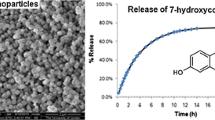Abstract
Different nanoporous silica materials, MCM-41, MCM-48 and SBA-15, were modified by pyridine and their applications for oral drug delivery system were evaluated. These pyridine functionalized nanoporous silicas were loaded with a water insoluble diorganotin(IV) dichloride complex as an antitumor drug model and its release from them were investigated by changing pH. An efficient pH-responsive carrier system was constructed by coordination of the pyridine group in modified nonoporous materials to tin complex. In vitro, releasing of loaded tin complex was studied in three different kinds of fluids, including a simulated gastric medium and a simulated body fluid. The loading and releasing of the diorganotin(IV) dichloride from various modified nanoporous silicas and also a non-porous silica (SiO2) were investigated, and the results were compared. In addition, the effect of some factors such as pH, time of loading and releasing were investigated through this study.







Similar content being viewed by others
References
Gielen M, Tiekink ERT (2005) Metallotherapeutic drugs and metal-based diagnostic agents. Willey, New York
Gasser G, Ott I, Metzler-Nolte N (2011) J Med Chem 54:3
Dyson PJ (2010) Aust J Chem 63:1503
Allardyce CS, Dyson PJ (2006) Top Organomet Chem 17:177
Ang WH, Daldini E, Scolaro C, Scopelliti R, Juillerat-Jeannerat L, Dyson PJ, Inorg Chem 45:9006
Davies AG, Gielen M, Pannell M, Tiekink ERT (2008) Tin chemistry: fundamental, frontiers, and application. Wiley, New York
Gielen M (1996) Coord Chem Rev 151:41
Gielen M, Tiekink ERT (2005) Metallotherapeutic drugs and metal-based diagnostic agents: the use of metals in medicine. Wiley, New York
Pillai O, Dhanikula AB, Panchagnula R (2001) Curr Opin Chem Biol 5:439
Slowing II, Vivero-Escoto JL, Wu Ch, Lin VSY (2008) Adv Drug Del Rev 60:1278
Ginebra MP, Traykova T, Planell JA (2006) J Control Release 113:102
Patri AK, Majoros IJ, Baker JR (2002) Curr Opin Chem Biol 6:466
Rezwan K, Chen QZ, Blaker JJ, Boccaccini AR (2006) Biomaterials 27:3413
Horcajada P, Chalati T, Serre Ch, Gillet B, Sebrie C et al (2010) Nat Mater 9:172
Jabbari Zahir Abadi I, Sadeghi O, Lotfizadeh Zhad HR, Tavassoli N, Amani V, Amini MM (2012) J Sol Gel Sci Technol 61:90
Tang F, Li L, ChenD (2012) Adv Mater 24:1504
Tang Q, Xu Y, Wu D, Sun Y, Wang J et al. (2006) J Control Release 114:41
Trewyn BG, Giri S, Slowing II, Lin VSY (2007) Chem Commun 2007:3236
Yang Q, Wang Sh, Fan P, Wang L, Di Y, Lin K, Xiao FS (2005) Chem Mater 17:5999
Gielen M (2002) Appl Organomet Chem 16:481
Hoogboom J, Garcia PML, Otten MB, Elemans JAAW, Sly J et al (2005) J Am Chem Soc 127:11047
Schumacher K, Grun M, Unger KK (1999) Micropor Mesopor Mater 27:201
Nunes CD, Valente AA, Pillinger M, Fernandes AC, Romao CC et al (2002) Mater Chem 12:1735
Nguyen TPB, Lee J, Shim WG, Moon H (2008) Micropor Mesopor Mater 110:560
Pirouzmand M, Amini MM, Safari N (2008) J Colliod Interface Sci 319:199
Cerneaux S, Zakeeruddin SM, Pringle JM, Cheng YB, Gratzel M, Spiccia L (2007) Adv Function Mater 17:3200
Smith PJ (1981) J Organomet Chem Libr 12:97
Gielen M, Eynde VI (1981) J Organomet Chem 217:205
Jabbari M, Gharib F, Amini MM, Azadmehr A (2008) Can J Chem 86:751
Hunziker RW, Escher BI, Schwarzenbach RP (2001) Environ Sci Technol 35:3899
Inaba K, Shiraishi H, Soma Y (1995) Water Res 29:1415
Vallet-RegO M, Balas F, Colilla M, Manzano M (2007) Drug Metab Lett 1:37
Balas F, Manzano M, Horcajada P, Vallet-Regi M (2006) J Am Chem Soc 128:8116
Zhang FA, Lee DK, Pinnavaia TJ (2010) Poly Chem 1:107
Qu F, Zhu G, Huang S, Li S, Sun J, Zhang D, Qiu S (2006) Micro Meso Mater 92:1
Andersson J, Rosenholm J, Areva S, Linden M (2004) Chem Mater 16:4160
Vallet-Regi M, Balas F, Arcos D (2007) Angew Chem Int Ed 46:7548
Acknowledgments
The authors thank the Vice-President’s Office for Research Affairs of Shahid Beheshti University for supporting this work.
Author information
Authors and Affiliations
Corresponding author
Rights and permissions
About this article
Cite this article
Vafaee, M., Amini, M.M., Najafi, E. et al. Modified nanoporous silicas for oral delivery of the water insoluble organotin compound: loading and release of methylphenyltin dichloride as an anti-tumor drug model. J Sol-Gel Sci Technol 64, 411–417 (2012). https://doi.org/10.1007/s10971-012-2871-y
Received:
Accepted:
Published:
Issue Date:
DOI: https://doi.org/10.1007/s10971-012-2871-y




